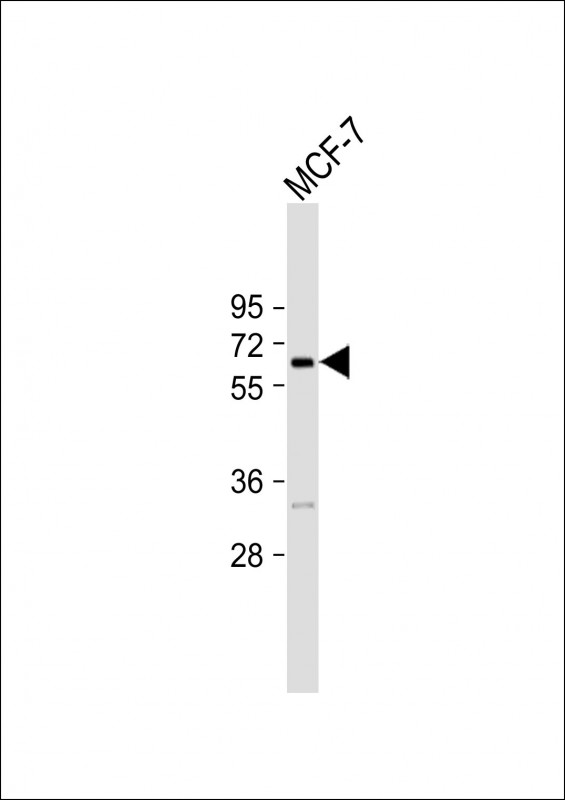FBXO9 Antibody (C-term)
Affinity Purified Rabbit Polyclonal Antibody (Pab)
- 产品详情
- 实验流程
- 背景知识
Application
| WB, E |
|---|---|
| Primary Accession | Q9UK97 |
| Other Accession | NP_036479.1 |
| Reactivity | Human, Mouse |
| Host | Rabbit |
| Clonality | Polyclonal |
| Isotype | Rabbit IgG |
| Calculated MW | 52329 Da |
| Antigen Region | 346-373 aa |
| Gene ID | 26268 |
|---|---|
| Other Names | F-box only protein 9, Cross-immune reaction antigen 1, Renal carcinoma antigen NY-REN-57, FBXO9, FBX9, VCIA1 |
| Target/Specificity | This FBXO9 antibody is generated from rabbits immunized with a KLH conjugated synthetic peptide between 346-373 amino acids from the C-terminal region of human FBXO9. |
| Dilution | WB~~1:1000 E~~Use at an assay dependent concentration. |
| Format | Purified polyclonal antibody supplied in PBS with 0.09% (W/V) sodium azide. This antibody is purified through a protein A column, followed by peptide affinity purification. |
| Storage | Maintain refrigerated at 2-8°C for up to 2 weeks. For long term storage store at -20°C in small aliquots to prevent freeze-thaw cycles. |
| Precautions | FBXO9 Antibody (C-term) is for research use only and not for use in diagnostic or therapeutic procedures. |
| Name | FBXO9 |
|---|---|
| Synonyms | FBX9, VCIA1 |
| Function | Substrate recognition component of a SCF (SKP1-CUL1-F-box protein) E3 ubiquitin-protein ligase complex which mediates the ubiquitination and subsequent proteasomal degradation of target proteins and plays a role in several biological processes such as cell cycle, cell proliferation, or maintenance of chromosome stability (PubMed:23263282, PubMed:34480022). Ubiquitinates mTORC1-bound TTI1 and TELO2 when they are phosphorylated by CK2 following growth factor deprivation, leading to their degradation. In contrast, does not mediate ubiquitination of TTI1 and TELO2 when they are part of the mTORC2 complex. As a consequence, mTORC1 is inactivated to restrain cell growth and protein translation, while mTORC2 is the activated due to the relief of feedback inhibition by mTORC1 (PubMed:23263282). Plays a role in maintaining epithelial cell survival by regulating the turn- over of chromatin modulator PRMT4 through ubiquitination and degradation by the proteasomal pathway (PubMed:34480022). Regulates also PPARgamma stability by facilitating PPARgamma/PPARG ubiquitination and thereby plays a role in adipocyte differentiation (By similarity). |
| Cellular Location | Cytoplasm. |
For Research Use Only. Not For Use In Diagnostic Procedures.
Provided below are standard protocols that you may find useful for product applications.
BACKGROUND
This gene encodes a member of the F-box protein family which is characterized by an approximately 40 amino acid motif, the F-box. The F-box proteins constitute one of the four subunits of the ubiquitin protein ligase complex called SCFs (SKP1-cullin-F-box), which function in phosphorylation-dependent ubiquitination. The F-box proteins are divided into 3 classes: Fbws containing WD-40 domains, Fbls containing leucine-rich repeats, and Fbxs containing either different protein-protein interaction modules or no recognizable motifs. The protein encoded by this gene belongs to the Fbxs class. Alternative splicing of this gene generates at least 3 transcript variants diverging at the 5' terminus.
REFERENCES
Jin, J., et al. Genes Dev. 18(21):2573-2580(2004)
Mungall, A.J., et al. Nature 425(6960):805-811(2003)
Scanlan, M.J., et al. Int. J. Cancer 83(4):456-464(1999)
Winston, J.T., et al. Curr. Biol. 9(20):1180-1182(1999)
Cenciarelli, C., et al. Curr. Biol. 9(20):1177-1179(1999)
终于等到您。ABCEPTA(百远生物)抗体产品。
点击下方“我要评价 ”按钮提交您的反馈信息,您的反馈和评价是我们最宝贵的财富之一,
我们将在1-3个工作日内处理您的反馈信息。
如有疑问,联系:0512-88856768 tech-china@abcepta.com.























 癌症的基本特征包括细胞增殖、血管生成、迁移、凋亡逃避机制和细胞永生等。找到癌症发生过程中这些通路的关键标记物和对应的抗体用于检测至关重要。
癌症的基本特征包括细胞增殖、血管生成、迁移、凋亡逃避机制和细胞永生等。找到癌症发生过程中这些通路的关键标记物和对应的抗体用于检测至关重要。 为您推荐一个泛素化位点预测神器——泛素化分析工具,可以为您的蛋白的泛素化位点作出预测和评分。
为您推荐一个泛素化位点预测神器——泛素化分析工具,可以为您的蛋白的泛素化位点作出预测和评分。 细胞自噬受体图形绘图工具为你的蛋白的细胞受体结合位点作出预测和评分,识别结合到自噬通路中的蛋白是非常重要的,便于让我们理解自噬在正常生理、病理过程中的作用,如发育、细胞分化、神经退化性疾病、压力条件下、感染和癌症。
细胞自噬受体图形绘图工具为你的蛋白的细胞受体结合位点作出预测和评分,识别结合到自噬通路中的蛋白是非常重要的,便于让我们理解自噬在正常生理、病理过程中的作用,如发育、细胞分化、神经退化性疾病、压力条件下、感染和癌症。






